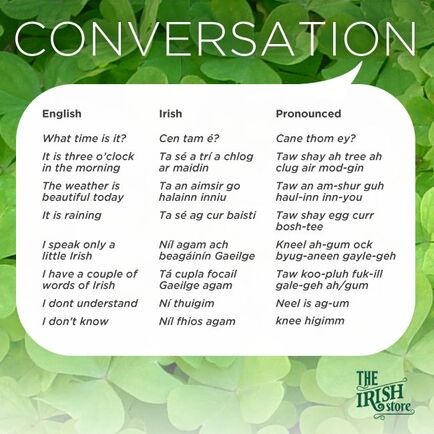 Some common phrases to help your own studies! Some common phrases to help your own studies! Volume X Part 4: Gaeilge/Éire It’s easy to forget that in Ireland people once mainly spoke, well, Irish. The Irish language, Gaeilge (also known as Éire or Irish Gaelic to differentiate it from Scottish Gaelic,) is the official language of Ireland (definitely not English.) Old Irish is considered the predecessor of all the Gaelic tongues, dating back at least 2,500 years (with its first known use in the Roman alphabet dating to the end of the 6th century—making it the oldest known written vernacular north of the Alps.) However, with the suppression of Irish culture by the British beginning in the 11th century, much of the original use of Irish was lost as English became the predominant language in governmental and legal affairs. By the time of The Great Famine from 1846-1848, Irish as a language was almost extinct. However, the Celtic revival and resurgence of the national Irish identity in the 1800s lead to increased interest in Gaeilge, lest it be forgotten. In 1897, the Society for the Preservation of the Irish Language was founded, and they were able to help reintroduce Irish into all levels of education—from primary to university. An official standard of the Irish language was set by the Irish government in 1958—though, the 2016 census reported that in modern times only 1.7% of the population speak Gaeilge daily. But what does this have to do with school life in Ireland? Quite a bit! Under current educational statutes, all students attending government-funded schools in Ireland (both primary and secondary) have a state-mandated Irish language curriculum. That means, in Ireland, you’re learning the country’s original language from at least first grade onward! In recent years, the requirement for a passing grade in Irish Gaelic for a graduating senior’s Leaving Certificate (see our previous post to have this better explained!) has been eradicated—meaning you still need to take the class, but aren’t tested on it as you will be for other subjects. This has caused some controversy within Ireland, as students argue that once they’re past primary school, Irish is no longer taught to them as a living language—it’s more a subject to get through. In fact, while only 5% of polled students said they thought Irish was properly emphasized as part of their cultural heritage, 67% of students believe that Gaeilge should be compulsory and further pushed as part of the country’s cultural heritage. But there are places where Irish continues to exist as a living language: Gaeilge-only schools! They’re called Gaelscoil or Irish-medium schools (while the majority of schools remain English-medium,) and while they can be hard to get into, they are completely immersive. While English is sometimes spoken in school as well, the primary language remains Irish throughout schooling. Parents often chose to send their children to a primary-level Gaelscoil and a standard secondary school, though secondary-level Gaelscoil have become more popular in recent years. While most parents cite language-acquisition and the importance of Irish culture and identity for choosing an Irish-medium program, there are other notable benefits that come with being bilingual: better academic performance overall, improvement in cognitive function, improved communication and social skills, and increased ease in learning third or even fourth languages. Like most topics that touch the political sphere, there’s plenty of controversy about Irish language requirements—most recently, primary school principals calling for a waiver of a Leaving Certificate qualification in Irish in due to a lack of suitable candidates (it’s not required, after all!) But the fact remains that Irish truly is a living language—just take a look at any government street sign, the average Irish person’s name, or innumerable place names and slang terms that still retain their Gaeilge roots. And then there’s the Gaeltacht areas of Ireland! These are places in Ireland where Irish remains the majority language, and they still exist today. Most of these areas dot the west coast of Ireland’s peninsulas where the language was protected by their remote locations. Though all that schooling might not prepare an Irish student for a conversation—while there’s a government-standard Gaeilge, there’s also three distinct dialects in the county: Ulster, Connacht, and Munster!
Where you fall on the bilingual debate? Immersive, required, or at parent and student discretion? Let us know in the comments! This post is part of a series. Take a look at our last modern Ireland post, all about university in Ireland, here. Also: check out the blog every Monday and Thursday for more posts about Irish history, dance culture, community news, and spotlights on our dancers, staff, and families—among other fun projects! And don’t forget to dance along with us on both Facebook and Instagram.
0 Comments
Your comment will be posted after it is approved.
Leave a Reply. |
SRL NewsFind all of our latest news on our Scoil Rince Luimni Facebook page! Categories
All
Archives
August 2022
|

 RSS Feed
RSS Feed